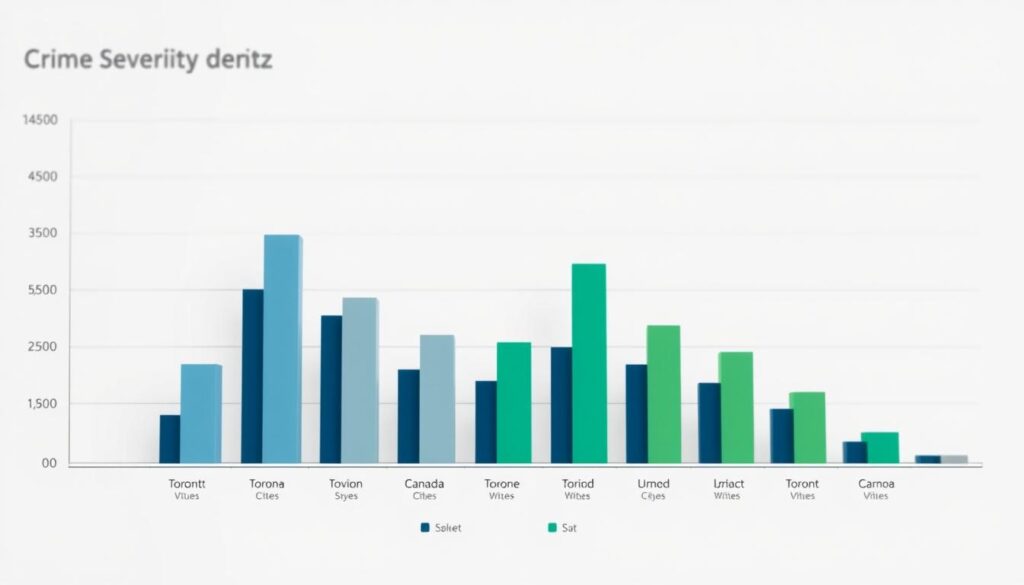Toronto is often regarded as one of the safest major cities in North America, a fact supported by its ranking as the 6th safest major city globally in 2024, according to The Economist. This distinction underscores the city’s low crime rate compared to other major metropolitan areas.
Despite recent fluctuations in crime statistics, Toronto maintains its reputation for safety. A closer examination of the city’s crime landscape reveals a complex picture, influenced by various factors including historical trends, neighborhood dynamics, and law enforcement strategies.
This article aims to provide a comprehensive analysis of Toronto’s crime rates, comparing them to other Canadian cities and major American metropolitan areas, and exploring the factors that contribute to its relative safety.
Toronto’s Current Crime Landscape
Toronto’s position as one of the safest major cities is backed by recent statistics. According to a 2024 report by CTV News, Toronto ranks as the safest city in Canada, with a crime rate of 286.9 offences per 100,000 residents, based on 2023 data.

Safety Ranking Among Global Cities
Toronto currently holds a prominent position in global safety rankings. The Economist Intelligence Unit has placed it as the 6th safest major city worldwide and the safest in North America in 2024. This ranking reflects the city’s strong infrastructure, effective policing strategies, and community-based safety initiatives.
Major Crime Indicators in 2024
Despite the positive global standing, crime rates in Toronto have shown fluctuations. Major Crime Indicators tracked by the Toronto Police Service show a slight decrease of 1.3% in 2024 compared to the previous year, with 37,320 major crimes investigated year to date.
| Year | Major Crimes | Change |
|---|---|---|
| 2023 | 39,019 | – |
| 2024 | 37,320 | -1.3% |
Comparison to Pre-Pandemic Crime Levels
When examining Toronto’s safety profile in comparison to pre-pandemic levels, certain crime categories have returned to or exceeded pre-pandemic numbers. This suggests a complex pattern of criminal activity rather than a simple increase or decrease.
The data indicates that while Toronto remains one of the safest major cities globally, there are nuances in its crime landscape that warrant continued attention from law enforcement and the community.
Historical Overview of Toronto Crime Rates
Understanding the historical context of crime in Toronto is crucial for grasping the city’s current safety landscape. Toronto’s crime history is marked by significant fluctuations, influenced by various social, economic, and demographic factors.

The “Year of the Gun” and Its Aftermath
In 2005, Toronto media coined the term “Year of the Gun” due to a record 52 gun-related homicides out of 80 total murders, nearly doubling the 27 gun deaths recorded the previous year. This period was followed by concerted efforts by law enforcement and community organizations to address gun violence, resulting in a gradual decline in homicide rates. According to the Toronto Police Service’s data, between 2009-2015, Toronto experienced a relatively stable period in terms of crime rates, with homicide totals hovering in the mid-50s.
As noted by crime analysts, “The period following the ‘Year of the Gun’ saw a significant decrease in gun-related violence, indicating the effectiveness of targeted interventions.” This stabilization was a result of collaborative efforts between law enforcement agencies and community organizations to address the root causes of violence.
Recent Crime Trends
The landscape shifted dramatically beginning in 2016, when Toronto saw a resurgence in violent crime, with homicides jumping to 75 that year and peaking at 98 in 2018, partially due to the Toronto van attack that claimed 10 lives. Recent crime trends from 2015 to the present have shown a complex pattern, with shooting incidents increasing from 177 in 2014 to an all-time high of 495 in 2019, followed by a consistent decline to 345 incidents by 2023, before rising again to 461 in 2024.
The fluctuations in crime rates over the years highlight the need for continued vigilance and adaptive strategies by law enforcement and community organizations. As crime trends continue to evolve, understanding these historical patterns is essential for developing effective crime prevention initiatives.
Top Ten Major Offences in Toronto
Crime statistics for Toronto in 2024 reveal a mixed picture, with some offenses on the rise and others in decline. The Toronto Police Service’s data provides a comprehensive overview of the city’s crime landscape, highlighting the most common major offenses.

The top ten major offenses reported by the Toronto Police Service for the year 2024 to date include a range of violent and property crimes. Assault remains the most frequently reported major offense, with 18,818 incidents reported, representing a 5.7% increase over the previous year.
Violent Crimes Statistics
Violent crimes continue to be a significant concern in Toronto. The data shows that assault with a weapon (4,489 incidents) and assault causing bodily harm (1,001 incidents) are among the top ten offenses. Additionally, robbery incidents have increased by 5.7%, with 2,312 cases reported, and robbery with a weapon specifically accounting for 988 of these incidents.
The statistics also reveal a concerning trend in sexual violations, which have increased by 13.1% with 2,630 reported cases. This rise in sexual violations raises concerns about personal safety in the city.
Property Crimes Statistics
Property crimes represent a significant portion of Toronto’s crime landscape. Auto theft, despite showing a significant 21.3% decrease from 2023 figures, still ranks as the second most common major offense with 7,045 reported incidents. Breaking and entering offenses have shown a modest decline of 3.6%, with 5,030 incidents reported.
Theft over $5,000 has shown a 15.7% decrease but still accounts for 979 reported incidents. The data indicates that while some property crimes are decreasing, they remain a prevalent issue in Toronto.
Toronto Crime Rates Compared to Other Canadian Cities
Toronto’s standing among Canadian cities in terms of crime rates is a crucial aspect of understanding its safety. When comparing Toronto’s crime rates with other Canadian cities, the data reveals significant variations in safety profiles across the country’s urban centers.
Toronto maintains a relatively favorable position despite recent increases in certain crime categories. The Crime Severity Index (CSI), which measures the volume and severity of police-reported crime, shows that Toronto’s CSI is lower than many other major Canadian cities.
Crime Severity Index Comparisons
The CSI is a valuable tool for comparing crime rates across different cities. According to recent data, Thunder Bay stands out with Ontario’s highest rate of both property crimes and violent crimes. In contrast, Toronto’s CSI is more favorable, positioning it as one of the safer large urban centers in Canada.

Homicide Rates Across Major Canadian Cities
Homicide rates across major Canadian cities show considerable variation. While Toronto experiences fluctuations, it generally maintains rates lower than cities like Winnipeg and Edmonton. Winnipeg, Manitoba, has emerged as Canada’s most violent city, with the highest per-person rate of violent crimes.
- Lethbridge, Alberta, holds the unfortunate distinction of ranking first for property crime among all Canadian cities.
- Kelowna ranked second among Canadian cities for property crime.
- Population density, socioeconomic factors, and regional differences play significant roles in shaping these comparative crime rates.
Understanding these differences is crucial for developing effective crime prevention strategies. By comparing crime rates across different Canadian cities, law enforcement and policymakers can identify areas for improvement and work towards creating safer communities.
Toronto vs. American Cities: Crime Rate Comparison
A recent study by the Fraser Institute has brought to light some surprising comparisons between crime rates in Toronto and several major U.S. cities. This comparison is crucial for understanding the relative safety of these urban centers.

Property Crime Comparison with New York and Other U.S. Cities
The Fraser Institute study reveals that Toronto’s property crime rate per person is 40 percent higher than New York City’s. This finding challenges common perceptions about safety in Canadian versus American urban centers. Toronto, along with other Ontario cities like Hamilton and Windsor, ranks higher for property crime than several American cities, including New York, Detroit, Flint, and Ann Arbor.
According to the comparative data analyzing crime rates per 100,000 people, Toronto’s property crime rate stands out as notably higher than its U.S. counterparts. This disparity highlights the need for a nuanced understanding of crime trends in different urban environments.
Violent Crime Comparison with U.S. Metropolitan Areas
Despite the concerning property crime statistics, Toronto maintains a relatively low homicide rate, fluctuating between 2.1 and 3.8 per 100,000 people over the 2010s. This rate positions Toronto favorably compared to many major U.S. metropolitan areas. When examining violent crime specifically, Toronto’s rates are substantially lower than those of American cities such as Atlanta (19.0 per 100,000), Chicago (18.5), Boston (9.0), and San Francisco (8.6).
The comparison underscores a significant disparity in violent crime between Canadian and U.S. urban centers, reflecting different approaches to policing, gun control, and social services. While Toronto’s homicide rate is higher than most European cities, it remains comparable to modern-day New York (5.1 per 100,000) and lower than many other major American metropolitan areas.
These comparative statistics suggest that while Toronto faces challenges with property crime, its population experiences significantly less risk of violent crime than residents of many similarly sized American cities.
Crime Distribution by Toronto Neighbourhoods
The distribution of crime across Toronto’s neighborhoods reveals a complex pattern, with certain areas standing out as having notably higher or lower crime rates. According to the Toronto Police Service’s Major Crime Indicators, there is a significant variation in crime distribution across the city.

Neighbourhoods with the Highest Crime Rates
The West Humber Clairville neighbourhood has reported the highest number of major crimes year to date, with 1,570 incidents as of September 2024. This represents a concerning 30.5% increase over the previous year. Other neighbourhoods experiencing high crime rates include Downtown Yonge East, Moss Park, York University Heights, and the Yonge-Bay Corridor, all of which have seen increases in reported major crimes.
- West Humber Clairville: 1,570 incidents (30.5% increase)
- Downtown Yonge East: 705 incidents (2.5% increase)
- Moss Park: 695 incidents (1.5% increase)
- York University Heights: 690 incidents (1.2% increase)
- Yonge-Bay Corridor: 590 incidents (0.7% increase)
Safest Areas in Toronto
In contrast, some neighbourhoods have demonstrated significantly lower crime rates. Woodbine-Lumsden stands out as Toronto’s safest neighbourhood, with only 50 reported major crimes year-to-date, representing a 35% decrease from the previous year. This neighbourhood, along with others experiencing low crime rates, highlights the importance of targeted community policing strategies.
The most dramatic year-to-date increases in crime have occurred in previously safer neighbourhoods, including Princess-Rosethorn, Kingsway South, Miliken, Bayview Woods-Steeles, and Banbury-Don Mills. These areas have seen significant percentage increases in major crimes, underscoring the need for enhanced security measures and community engagement.
- Princess-Rosethorn: 215.3% increase
- Kingsway South: 140.7% increase
- Miliken: 110.5% increase
- Bayview Woods-Steeles: 103.2% increase
- Banbury-Don Mills: 90.1% increase
Public Transit Safety Concerns in Toronto
Toronto’s public transit system, managed by the Toronto Transit Commission (TTC), has faced significant safety concerns in recent years. The issue of safety on public transit is multifaceted, involving various factors that contribute to the overall feeling of security among passengers.
Violent Crimes on TTC
According to the TTC’s latest data, there was a concerning increase in violent incidents against passengers in 2022, marking a 46% rise compared to the previous year. This surge resulted in a total of 1,068 violent incidents, which included assaults, robberies, theft, mischief, and harassment. The nature of these incidents was particularly alarming, with reports of passengers being shoved onto tracks, lit on fire, stabbed, swarmed, and shot at with BB guns. Such high-profile incidents heightened anxiety among regular transit users.
However, there was a welcome decrease in offenses against TTC riders between January 2023 and January 2024, with a reported 24% decrease in the rate of offenses. This improvement suggests that the security measures implemented may be having a positive impact on transit safety.

Security Measures Implemented
In response to the rise in violence on the TTC, authorities have taken comprehensive steps to enhance security. This includes the deployment of 80 Toronto Police officers for 24-hour patrols throughout the transit system. Additionally, 20 community safety ambassadors and 50 security guards have been strategically positioned throughout the transit network. These measures represent a multi-faceted approach to addressing violence and improving passenger safety on Toronto’s public transportation system.
The introduction of these security enhancements aims to not only reduce crime but also to reassure passengers of their safety while using the TTC. By combining increased police presence with community-focused initiatives, the authorities aim to create a safer environment for everyone.
Organized Crime in Toronto
Organized crime has been a persistent issue in Toronto, evolving significantly since its early days with the Markham Gang. The city’s history with organized crime is complex, with various international crime syndicates having operated within its borders over the years.

Evolution of Organized Crime
The historical development of organized crime in Toronto was significantly influenced by the prohibition era, during which the city became a major hub for bootlegging operations into the United States. This period saw an influx of Italian-American organized crime groups, including the Buffalo crime family. Italian organized crime groups, such as the Calabrian ‘Ndrangheta (e.g., the Siderno Group) and the Sicilian Mafia, have maintained a significant presence in Toronto for decades, engaging in various criminal activities ranging from extortion to drug trafficking.
According to the Fraser Institute, organized crime networks in Toronto have adapted their operations over time, shifting from traditional activities like bootlegging and gambling to more sophisticated operations, including auto theft rings, human trafficking, and cybercrime. This evolution has presented ongoing challenges for law enforcement agencies.
Current Organized Crime Activities
Current organized crime activities in Toronto include complex auto theft operations, which have contributed to the city’s high rate of vehicle thefts. Stolen vehicles are often shipped overseas through elaborate criminal networks. Law enforcement agencies, including specialized police units, have developed sophisticated methods to combat organized crime. However, criminal organizations continue to evolve their tactics to evade detection and prosecution, posing ongoing challenges for the government and law enforcement officials.
The presence of organized crime in Toronto is a multifaceted issue, requiring a comprehensive approach to address its various aspects. Understanding the historical context and current activities of organized crime is crucial for developing effective strategies to combat it.
The Canadian Criminal Code and Toronto Crime
The Canadian Criminal Code plays a crucial role in shaping Toronto’s crime landscape. It serves as the foundational legal framework governing criminal activities in the city, establishing definitions, procedures, and penalties for various offenses.

Key Provisions and Their Relevance
Key Criminal Code provisions particularly relevant to Toronto’s crime landscape include those addressing violent crimes (such as murder, assault, and robbery), property crimes (theft, breaking and entering), weapons offenses, drug crimes, and organized criminal activities. For instance, provisions related to property crimes are especially pertinent given that Toronto’s property crime rates exceed those of New York City by approximately 40%, as indicated by data from the Fraser Institute.
Impact on Crime Rates
The enforcement of these provisions by the Toronto Police Service directly impacts crime rates in the city. Variations in Criminal Code enforcement strategies over time have correlated with fluctuations in Toronto’s crime rates. For example, recent amendments to the Criminal Code have targeted emerging crime trends, such as organized retail theft and auto theft rings, which have seen significant incidents in Toronto, with 7,045 reported auto thefts in 2024.
Conclusion: Preventing Crime and Improving Safety in Toronto
The recent surge in crime rates across Toronto has sparked a need for comprehensive analysis and action. While Toronto’s crime rates remain relatively low compared to historical standards and many other major North American cities, the concerning increases in certain categories necessitate a proactive approach to crime prevention.
Data from the Fraser Institute and Toronto Police Service reports indicate that a targeted strategy is required, focusing on property crimes, which exceed New York’s rates by 40%, and violent crimes on public transit, which have seen fluctuations in recent years. Effective crime prevention involves a multi-faceted approach, including law enforcement, community organizations, government agencies, and citizens working together to address the root causes of criminal behavior.
Successful strategies from other Canadian cities and international urban centers can be adapted to Toronto’s context, emphasizing neighborhood-level interventions in high-crime areas. Technology and data analytics are crucial in modern crime prevention, enabling precise resource targeting and effective crime trend monitoring across Toronto’s diverse communities and population centers. As Toronto grows, maintaining its favorable safety ranking among global cities will require ongoing investment in crime prevention, community policing, social services, and public education to ensure a safe and secure urban environment for all residents.

